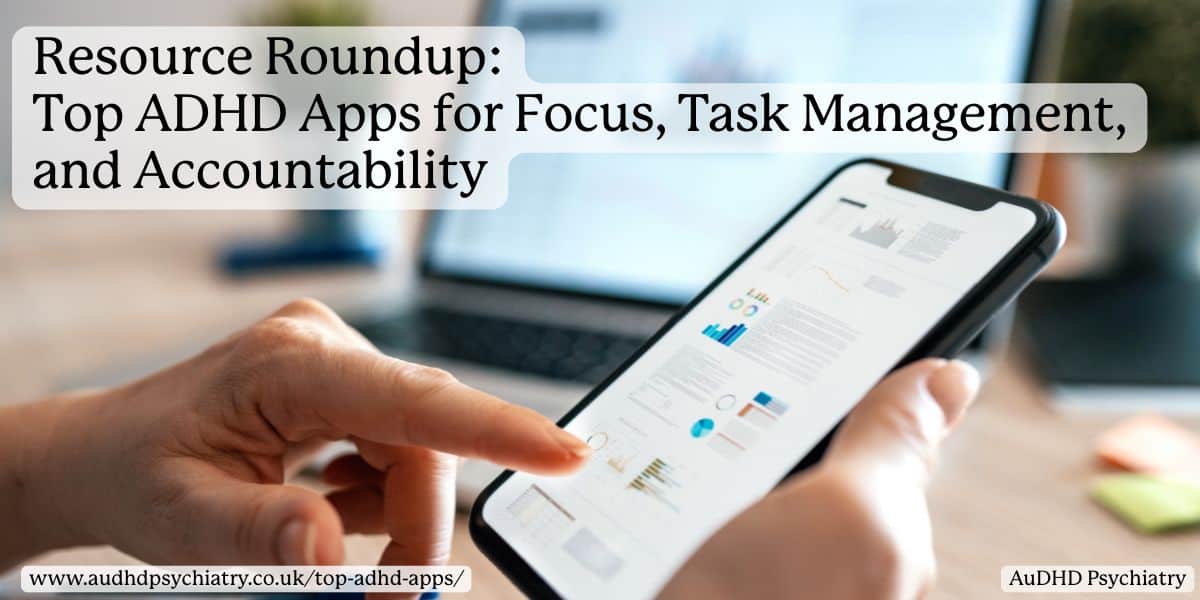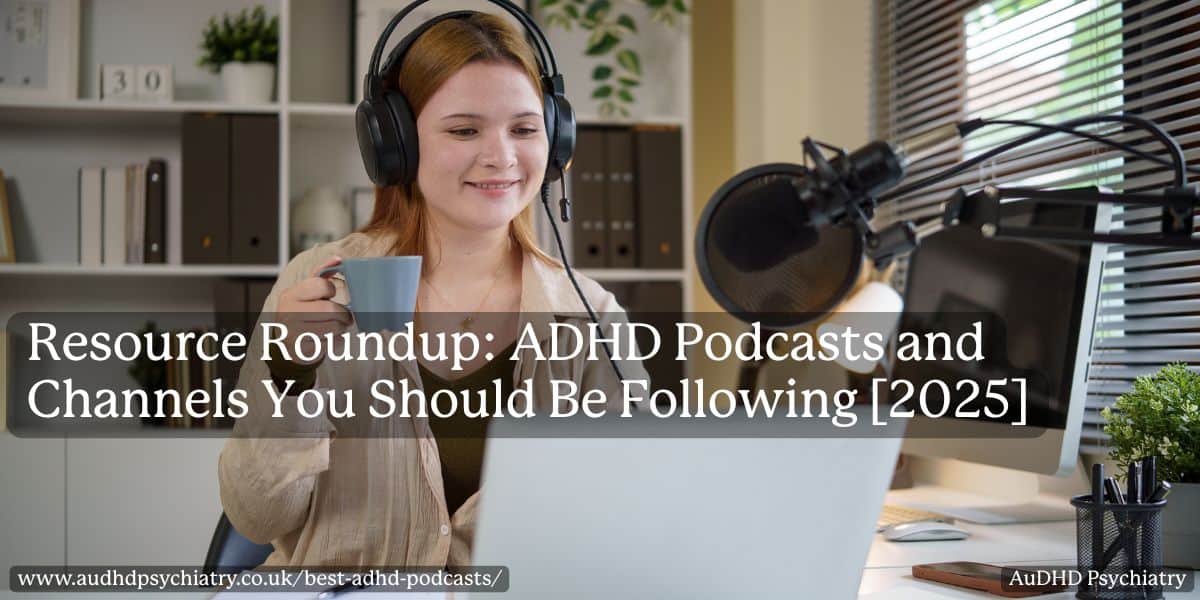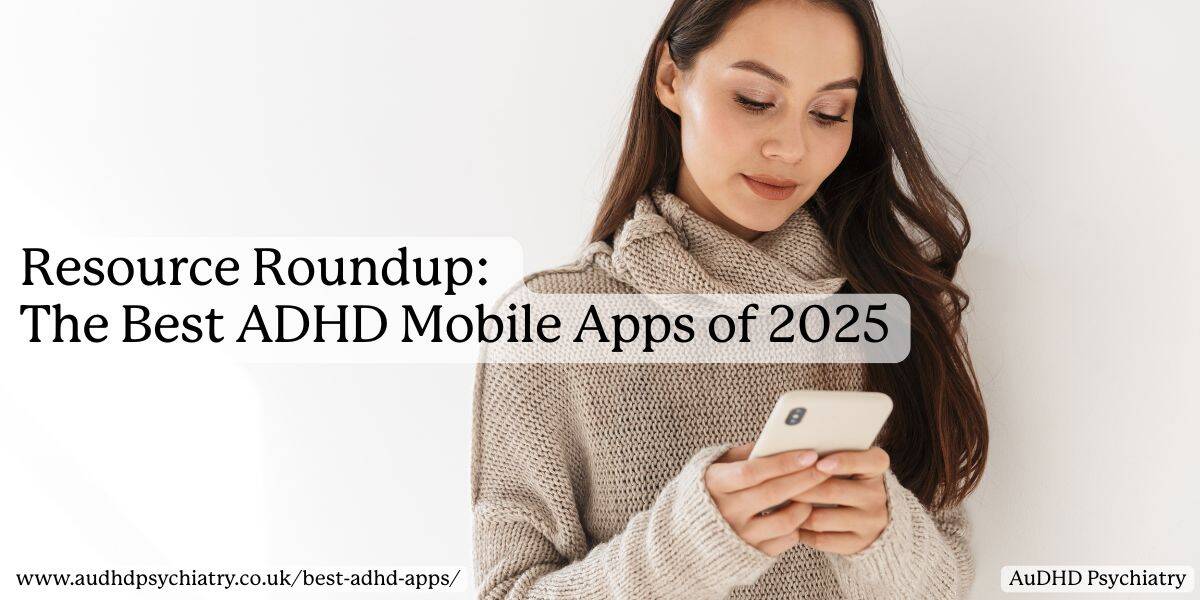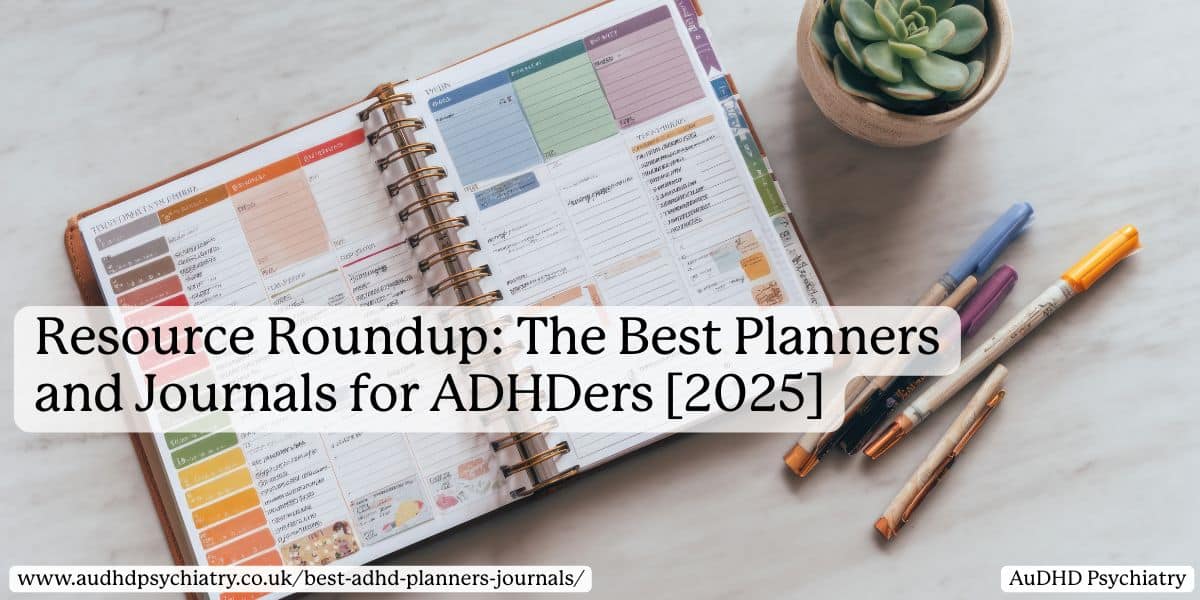
If you live with ADHD, you’ll know the frustration of forgetting appointments, losing track of daily tasks, or struggling with time management despite your best efforts. That’s why finding the best ADHD planner or journal is more than just organisation. It’s also creating tools that actually work for your brain.
This article offers the best planner options for ADHDers in 2025. From paper planners to digital calendars and hybrid systems, we’ll explore how each tool supports different planning styles.
We’ll look at:
- The benefits of using ADHD-friendly planners and journals.
- Key features that provide structure for daily life.
- The top planner and journal choices for the year ahead.
This guide will help you find practical, sustainable tools to support productivity and wellbeing.
What Are the Benefits of ADHD Planners and Journals?
For the ADHD brain, daily life can feel unpredictable. Symptoms such as distractibility, forgetfulness, and difficulty with organisation make it challenging to keep track of commitments. This is where planners and journals come in. They provide structure, clarity, and a sense of control.
Supporting Daily Responsibilities
One of the greatest benefits of planners is how they help break down daily responsibilities into smaller, manageable steps. Having a dedicated space to record important dates, tasks, and reminders reduces reliance on working memory, which is often affected in ADHD. For many, simply seeing responsibilities written down makes it easier to prioritise and follow through.
Planners as a Great Tool for Structure
A well-designed planner can be a great tool for reinforcing structure in daily life. Whether it’s setting out routines, blocking out time for specific activities, or creating visual cues for deadlines, planners help make the abstract more concrete. Visual planners give ADHD adults an external system for managing responsibilities, which lowers stress and improves consistency.
The Role of Journaling in Mental Health
Journaling adds a different but complementary benefit. Beyond tracking tasks, it supports mental health and personal development. Regular writing can help identify patterns in behaviour, highlight triggers, and provide a safe outlet for emotions. Journaling also fosters self-reflection, encouraging people to set goals and monitor progress over time.
For those dealing with the symptoms of ADHD, journaling can also help strengthen executive functioning by promoting mindfulness and self-awareness. Many ADHDers find that combining a planner with a journal offers the best balance—structure for tasks, and reflection for growth.
Why It Matters
Together, planners and journals act as anchors in daily routines. They reduce overwhelm, improve reliability, and provide tools for long-term wellbeing. We’ll discuss more about how these tools go hand in hand in a later section.
The Best ADHD Planners and Journals for 2025
There is no one-size-fits-all planner, but some options consistently stand out for their flexibility, design, and ADHD-friendly features. Below are some of the best planner options for 2025, each with unique strengths to support different planning styles.
Bullet Journal
The Bullet Journal system is highly flexible and appeals to creative ADHDers who want complete control over their layouts. Users can design to-do lists, trackers, and monthly spreads using colored pens, highlighters, and bright colours for visual organisation. The downside is that it requires time and consistency to set up, which may be a challenge for those who struggle with long tasks. Still, for people who enjoy customisation, it can be a great option.
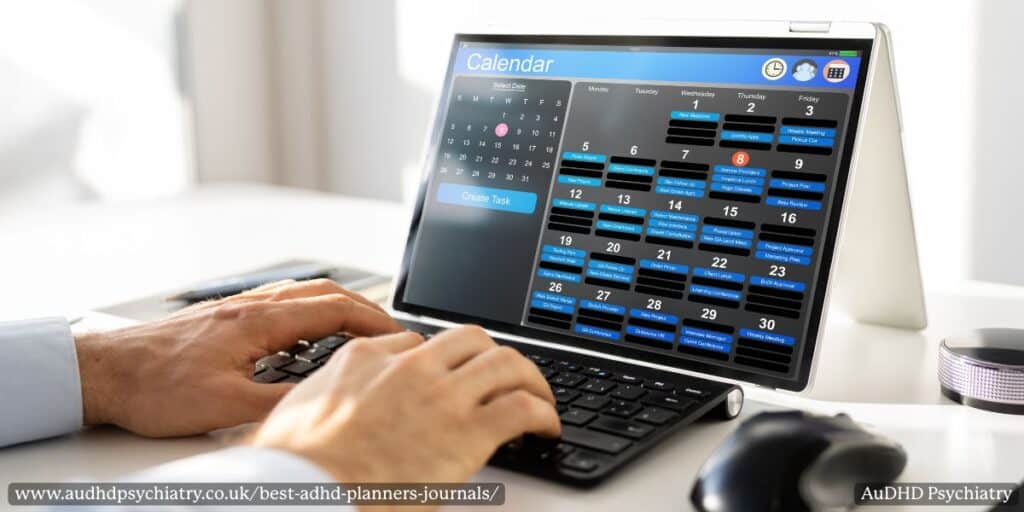
Google Calendar Suite
The Google Calendar Suite works well as a digital-first ADHD planner app. It syncs across devices, integrates with email, and allows you to set notifications and recurring reminders. Its biggest advantage is accessibility. Whether on your phone, tablet, or desktop, your schedule is always at hand.
Visual colour coding also helps beat time blindness by highlighting important tasks and deadlines. The limitation is that it may feel less tangible for those who prefer physical planners.
Planner Pad
Planner Pad is known for its unique funnel-down design. Users begin with a broad overview of important tasks, then break them into weekly and daily plans. This structure mirrors how ADHD adults often think” big ideas first, then detail. It helps avoid overwhelm by creating a step-by-step process for tackling projects. While not as customisable as some planners, its built-in system makes it easier to stay on track without overplanning.
Passion Planner
The Passion Planner combines structure with inspiration. It includes monthly planners, weekly layouts, and goal-setting pages, as well as space for reflection and personal growth. Many users find the motivational prompts helpful for connecting daily routines to bigger life goals. The downside is that it can feel text-heavy, but for people who like guided direction, it’s a high-quality planner that supports both productivity and personal development.
Panda Planner
Panda Planner is designed with productivity psychology in mind. Its sections for priorities, gratitude, and reflection can help ADHD adults focus not just on tasks but also on mindset. The inclusion of habit tracking and progress check-ins makes it easier to track accomplishments on a daily basis. Some may find the structured approach restrictive, but it provides excellent scaffolding for those who need accountability.
Agendio Planner / Notebook
The Agendio Planner and Agendio Notebook stand out because they are fully customisable planners. You can design planner layouts to suit your needs, whether that’s extra space for to-do lists, project manager pages, or colourful inserts. Different sizes and formats are available, making them adaptable to a variety of lifestyles. The main drawback is cost, as customisation can make them pricier than mass-produced planners. Still, for ADHDers who need flexibility, they’re a great option.
ClickUp
While not a physical planner, ClickUp functions as a robust digital planning tool. It’s ideal for those managing complex schedules or collaborative projects. Features include task boards, deadline reminders, and integration with other productivity apps. ADHD adults may find its versatility empowering, but its wide range of functions can also become overwhelming if not kept simple. For people comfortable with digital systems, it’s an effective ADHD planner app.
Plum Paper Planner
Plum Paper Planners are known for being highly customisable and available in different sizes. Users can choose add-ons like fitness logs, meal planners, or study schedules, which make them useful for students and professionals alike. The smooth paper quality supports the use of colored pens and highlighters, and the layouts balance structure with personalisation. The only drawback is that it takes time to select and design the perfect planner before ordering.
MakseLife
MakseLife is designed with an emphasis on both planning and goal setting. Each planner includes space for monthly views, weekly breakdowns, and reflective exercises. The layouts encourage balance between productivity and well-being, helping users align daily tasks with long-term personal goals. Some may find the system slightly advanced at first, but once mastered, it becomes a powerful planner system.
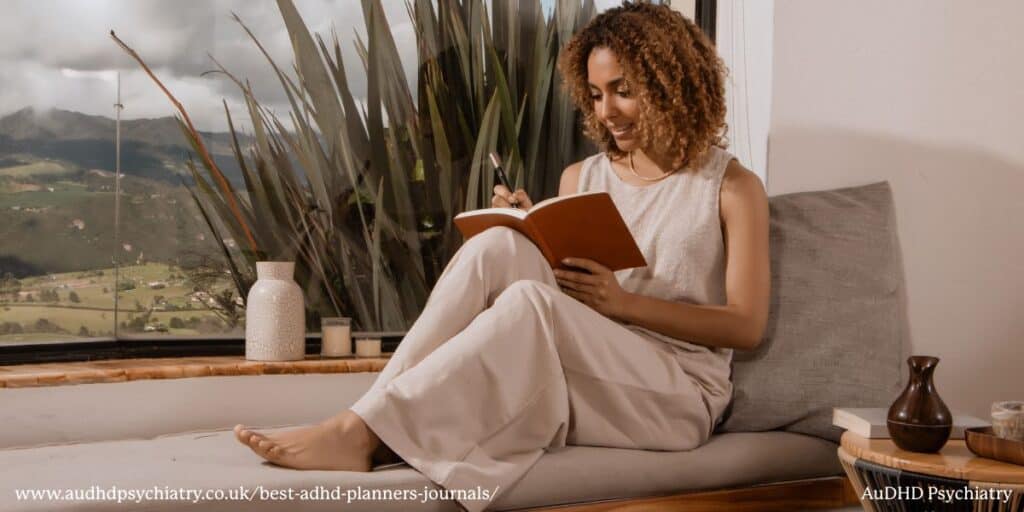
Guided Journals
Guided journals, such as gratitude journals, prompted self-reflection books, or ADHD-focused guided notebooks, are excellent companions to planners. They encourage mindfulness, improve emotional regulation, and help track progress on a daily basis. While they don’t provide scheduling features, they enhance self-awareness and support mental health. When paired with a structured planner, they create a balanced routine of planning and reflection.
Choosing the Right Planner
Each of these tools presents unique features to support ADHD adults in managing daily tasks, staying aware of important deadlines, and creating meaningful routines. Whether you prefer the creativity of a Bullet Journal, the structure of Planner Pad, or the flexibility of digital tools like ClickUp, the most effective planner is the one that matches your style. By experimenting with different systems, you can find the best ADHD planner for your needs in 2025.
Key Features to Look for in ADHD Planners and Journals
The most effective planner for ADHD isn’t always the most expensive or popular one. It’s what matches your needs and planning style. Certain features can make a big difference in helping you stay on top of important deadlines and daily routines.
Weekly, Daily, and Monthly Views
A strong ADHD planner should include flexibility between a weekly planner, daily planner, and a monthly planner.
- Weekly views help keep track of upcoming tasks and deadlines.
- Daily pages allow you to break tasks into smaller steps and record detailed task lists.
- Monthly layouts provide the big picture, making it easier to plan for events or long-term projects.
Having multiple perspectives in one planner supports both immediate organisation and long-term planning.
Tools for Building Routines
Many ADHD-friendly planners include a habit tracker or goal-setting planner section. These tools provide accountability and visual feedback on progress, which can motivate consistency in building a daily routine. Even small wins, like ticking off water intake or daily exercise, can improve confidence and structure.
Customizable Layouts
A customisable planner is especially helpful for ADHD adults who prefer flexibility. Features like customisable layouts, add-on inserts, or undated pages mean you can adapt the planner without the pressure of wasted pages. This approach also reduces the risk of abandoning the planner when life gets busy.
Some planners also use a folio system, allowing you to rearrange inserts, add sections, or remove pages. This flexibility makes it easier for ADHD adults to adapt their planners as routines change.
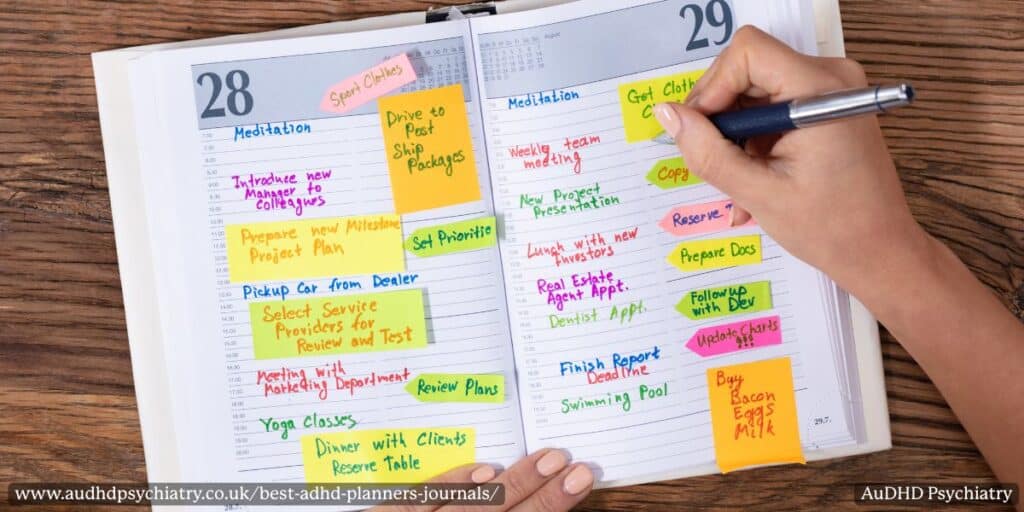
Practical Additions
Small extras can make planning easier and more engaging. Sticky notes are ideal for shifting tasks around without clutter. Colour coding with pens or tabs adds visual appeal and organisation. These may seem simple, but they reduce cognitive load and make it easier to remember priorities.
By combining multiple views, structured tools, and customisable options, ADHDers can choose a planner that not only manages daily routines but also supports broader goals. The right features help transform planners and journals from simple organisers into reliable companions for everyday life.
Choosing Between Paper and Digital ADHD Planners
Finding the right type of planner depends on personal preference, lifestyle, and how your ADHD symptoms show up in daily routines. Looking at digital vs paper planners, each type has its strengths. For many, the best solution is a mix of the two.
Paper Planners
A paper planner offers a tactile experience that many ADHDers find grounding. Writing by hand creates a stronger memory link, while visual additions like bright colours, colored pens, and even washi tape make the process more engaging. Paper planners are also free from digital distractions, which can be helpful for staying focused.
Digital Planners and Calendars
A digital planner or calendar provides flexibility for those managing a busy schedule. They sync across mobile devices, allow you to set reminders, help with time blocking, and often integrate with other productivity tools. The ability to schedule recurring events, add note pages, and receive notifications makes them a powerful option for people who prefer structured digital systems.
For more on digital versus paper tools, see our guide on ADHD in the Digital Age: Managing Screen Time and Social Media.
Hybrid Systems
For many, the best option is a hybrid approach. Using a paper planner for creative planning and daily checklists while relying on digital calendars for deadlines and appointments combines the strengths of both planning systems. This method also provides multiple visual reminders, increasing the chances of tasks being completed on time.
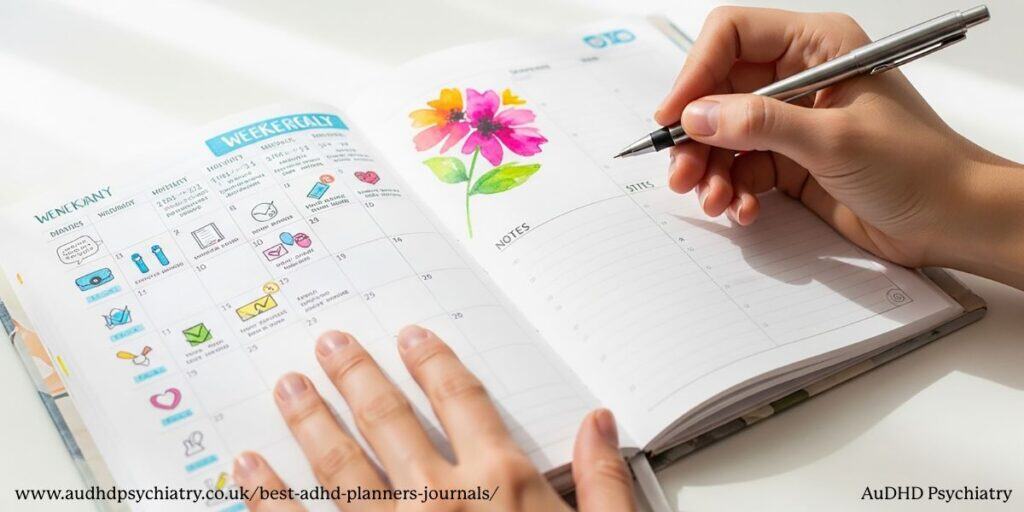
How Journaling Complements ADHD Planners
Planners and journals work best when used together. While a planner helps structure daily tasks and keep track of important deadlines, journaling supports reflection, emotional regulation, and self-awareness. For ADHD adults, combining the two can create a balanced planning system that strengthens both productivity and well-being.
Supporting Executive Functioning
One of the biggest challenges for people with ADHD is managing executive functioning skills—planning, prioritising, and sequencing tasks. Journaling allows you to capture thoughts, ideas, and distractions in a structured way, which frees up mental space for what matters. When paired with a planner, these notes can be translated into clear action steps.
Reducing Overwhelm
Journaling provides a safe outlet for stress and frustration, helping reduce the sense of overwhelm that often accompanies ADHD. By externalising thoughts, you create distance from them, making it easier to focus on the day ahead. Planners then take over by turning that clarity into a manageable schedule.
Progress Tracking on a Daily Basis
Planners show what needs to be done, while journals capture how you’re doing. Using tools like a gratitude journal, a prompted journal, or an ADHD-focused guided notebook lets you reflect on progress, moods, and patterns on a daily basis. This feedback loop helps you adjust routines and build habits that stick.
Together, planners and journals form a system that addresses both organisation and self-reflection—two essential ingredients for long-term ADHD symptom management.
Tips for Using a Planner or Journal with ADHD
Even the best ADHD planner won’t be effective unless it’s used consistently and in a way that suits your planning style. The following tips can help ADHD adults make the most of planners, journals, and apps, turning them into tools that genuinely support daily accomplishments.
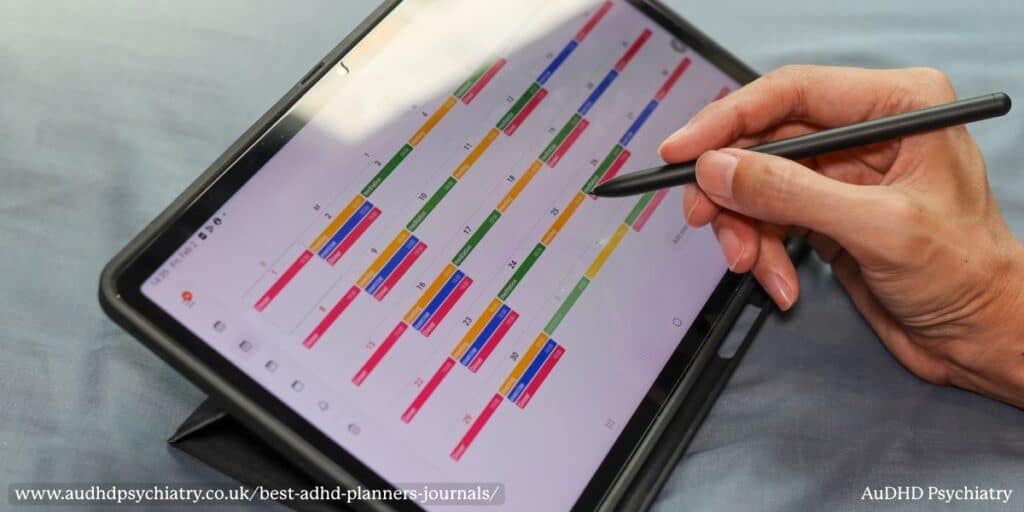
Make It Visually Engaging
ADHD brains respond strongly to visual stimulation. Adding highlighters, colored pens, and bright colours can transform a plain planner into something enjoyable to use. Try using colour-coding systems, such as:
- Blue for work tasks.
- Green for health routines.
- Red for urgent or important deadlines.
This visual system doubles as a set of visual cues, making it easier to see priorities at a glance.
Break Down Long Tasks
Large projects often feel overwhelming, leading to procrastination or avoidance. To stay on track, break long tasks into smaller, actionable steps. For example, instead of writing “finish project,” divide it into subtasks such as “draft outline,” “write introduction,” and “review sources.” Checking off smaller steps provides motivation and reduces the sense of being stuck.
Build Consistent Routines
The key to getting value from any planner or journal is consistency. Create a habit of checking your planner at the same time each day: morning for planning, evening for reflection. Establishing consistent routines also helps balance energy levels throughout the day, making it easier to manage time effectively.
Avoid the Rabbit Hole of Over-Planning
It’s easy to spend too much time decorating, rewriting, or redesigning your planner. This can potentially lead to the rabbit hole of planning instead of doing. Keep layouts simple at first, then add design elements gradually if they genuinely help with focus.
Celebrate Daily Accomplishments
Don’t just track tasks. Track progress. Use a section of your planner or journal to record daily accomplishments, no matter how small. Recognising achievements reinforces positive habits and provides encouragement to keep going.
For additional guidance, see our resource on How to Deal with Task Paralysis. This guide complements planner use by showing how to overcome the mental blocks that often get in the way.
When Planners and Journals Aren’t Enough
Using an academic planner, journal, or calendar can be a powerful support, but these are not a cure for ADHD. Attention deficit hyperactivity disorder is a neurodevelopmental disorder, which means its challenges run deeper than organisation alone. Tools may help manage daily tasks, but some symptoms require structured clinical support.
Why Professional Care Matters
Even the most appropriate planner cannot replace evidence-based treatment. For some ADHD adults, consistent journaling and planning provide structure, but they may not fully resolve difficulties with focus, impulsivity, or emotional regulation. In these cases, ADHD medication and therapy play a central role in ADHD symptom management. Understanding when it’s time to seek extra help ensures you’re not relying on tools that were never designed to act as treatment.
If you find yourself consistently overwhelmed despite trying multiple planners, this could be a sign to seek professional support. At AuDHD Psychiatry, we provide comprehensive ADHD assessments personalised for your unique needs, helping you decide on the right mix of strategies and treatment.
Best ADHD Planners Journals: Wrapping It Up
There is no single perfect planner for ADHD. Most people try plenty of planners before finding the right fit. What matters most is choosing a system that supports your daily accomplishments, aligns with your personal goals, and integrates with broader support programs.
Planners and journals can make a big difference, but the best thing you can do is pair them with professional guidance. If you’re ready to go beyond trial and error, book your assessment today and take the first step towards a personalised ADHD plan that works.
You Might Also Like
Contact Us
We’re here to answer any questions you might have.
Get in Touch
Opening Hours
Contact Form
We’re here to help. Reach out and we’ll get back to you within 24 hours (Monday – Friday).

